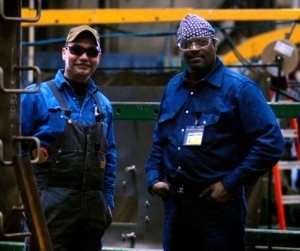 In this last post (for now) on my series on shop floor management I will talk about how to conduct a shop floor meeting. Who should be there; when, how long, and how often you should have such a meeting; and what is on the agenda. I will also talk about common mistakes that you should avoid.
In this last post (for now) on my series on shop floor management I will talk about how to conduct a shop floor meeting. Who should be there; when, how long, and how often you should have such a meeting; and what is on the agenda. I will also talk about common mistakes that you should avoid.
Who Should Participate in a Shop Floor Meeting
 The shop floor meeting is primarily for the people on the shop floor. Since in all likelihood your entire factory is too large for a meaningful single meeting, such meetings should happen for different sections of your factory separately. Align this with the structures you already have in place. Every foreman/supervisor conducts a meeting for his own team. In my experience, the number of participants range somewhere from 3 to 20, although I prefer 5 to 10 to keep it manageable and effective.
The shop floor meeting is primarily for the people on the shop floor. Since in all likelihood your entire factory is too large for a meaningful single meeting, such meetings should happen for different sections of your factory separately. Align this with the structures you already have in place. Every foreman/supervisor conducts a meeting for his own team. In my experience, the number of participants range somewhere from 3 to 20, although I prefer 5 to 10 to keep it manageable and effective.
Besides the workers and the supervisor, you may have other people involved, as for example logistics, maintenance, management, or other support staff. But please be considerate of their time too. Even if you distribute the shop floor meetings across the day, a support staff worker will do nothing else if there are twelve meetings to attend every day. A common strategy is to have the support staff join not daily, but once per week or once per month, depending on the number of shop floor meetings you have in their area of responsibility altogether.
Another option is to invite support staff on a case-by-case basis. If a problem benefits significantly from the attendance of a certain support staff, then this support staff may join for one meeting or a small number of meetings to help resolve the issue.
I have seen attendance of upper management up to the plant manager on a regular basis. The plant manager attended a different meeting every day, and his attendance was tracked by the shop floor meeting supervisor.
How Often, How Long, and When Should You Have a Shop Floor Meeting
 A shop floor meeting should happen with every shift. All the employees currently working in this section of the shop floor should attend. The duration varies, but is often somewhere between 10 and 30 minutes. Don’t make it too long, since this will directly reduce productivity.
A shop floor meeting should happen with every shift. All the employees currently working in this section of the shop floor should attend. The duration varies, but is often somewhere between 10 and 30 minutes. Don’t make it too long, since this will directly reduce productivity.
Usually it is at the beginning of a shift to get the maximum benefit from the information shared. However, if multiple teams use the same team corner space, or if a manager wants to attend multiple meetings, the start of such meetings can be adjusted. In other words, Team 1 meets 8:00 to 8:20; Team 2 8:20 to 8:40; and team 3 8:40 to 9:00 in the same team corner. Similarly, if the shop floor supervisor and his team meets at 8:00 to 8:20, with the shop floor manager in attendance; the overarching shop floor manager meets and his staff meet afterwards. Naturally it makes sense to start the meetings at the lowest hierarchies and work your way upward. This permits the fastest transfer of information from the shop floor (the “Gemba“) upwards.
How to Conduct a Shop Floor Meeting
 The shop floor meeting usually has only a few agenda points. It often starts with taking attendance. Next comes a look at the key performance indicators of the previous day. These usually include safety, quality, and cost or performance. If an accident happened it should be discussed(briefly) to prevent reoccurrence. If it is a bigger issue to solve a separate meeting or project may be necessary, as the shop floor meeting is too short for a detailed analysis.
The shop floor meeting usually has only a few agenda points. It often starts with taking attendance. Next comes a look at the key performance indicators of the previous day. These usually include safety, quality, and cost or performance. If an accident happened it should be discussed(briefly) to prevent reoccurrence. If it is a bigger issue to solve a separate meeting or project may be necessary, as the shop floor meeting is too short for a detailed analysis.
Another block looks at current problems and improvement activities. What went wrong yesterday? What is the progress of the open items in the improvement list. Please keep in mind that this meeting does not have enough time for extended discussions, the focus is on conveying information. If there are non-obvious problems to solve, a separate problem solving process should be initiated. A third block may give various updates and organizational information that came up since the last meeting.
In pretty much all cases I know, this was a standing meeting. In general, standing meetings tend to be shorter. Besides, you usually don’t have the space to put up chairs on the shop floor.
Outside of the Shop Floor
 Similar meetings are also becoming more common outside of the shop floor. Such meetings could happen, for example, with logistic teams (which I have done myself regularly when I was a manager of such a team), or maintenance, or any other organizational groups. Things on the shop floor change with a very high frequency, and due to the nature of the work there is usually not as much time to exchange information. Hence, a meeting every shift is well justified.
Similar meetings are also becoming more common outside of the shop floor. Such meetings could happen, for example, with logistic teams (which I have done myself regularly when I was a manager of such a team), or maintenance, or any other organizational groups. Things on the shop floor change with a very high frequency, and due to the nature of the work there is usually not as much time to exchange information. Hence, a meeting every shift is well justified.
However, this may be different in other areas outside of production. It may be justified to meet only twice or three times per week, or even only weekly. If it is less than weekly, however, these meetings start to lose their effect.
Common Mistakes in Shop Floor Meetings
 There are a few common mistakes in shop floor meetings. Probably the biggest one is to let it degrade into a discussion group. Pros and cons are argued, or even worse, blame is assigned, and the time is up before reaching any meaningful conclusion. The next day the story repeats, and since the points from yesterday are repeated no progress is made.
There are a few common mistakes in shop floor meetings. Probably the biggest one is to let it degrade into a discussion group. Pros and cons are argued, or even worse, blame is assigned, and the time is up before reaching any meaningful conclusion. The next day the story repeats, and since the points from yesterday are repeated no progress is made.
 Another common problem is the opposite: A lack of employee involvement. Only the boss talks and the employees listen. It is good practice to assign different parts of the meeting to different employees. Employee A takes attendance. Employee B goes through the KPI, and so on. Not only does this significantly increase the involvement of the employees, it also frees up the mind of the supervisor from organizational tasks and gives more time for actual knowledge value add, and maybe even a little bit of coaching and mentoring. Also allow the employees to adjust the content of the team corner. Some companies provide a shop floor meeting template, but often it is better to adjust this template to the actual needs of the team.
Another common problem is the opposite: A lack of employee involvement. Only the boss talks and the employees listen. It is good practice to assign different parts of the meeting to different employees. Employee A takes attendance. Employee B goes through the KPI, and so on. Not only does this significantly increase the involvement of the employees, it also frees up the mind of the supervisor from organizational tasks and gives more time for actual knowledge value add, and maybe even a little bit of coaching and mentoring. Also allow the employees to adjust the content of the team corner. Some companies provide a shop floor meeting template, but often it is better to adjust this template to the actual needs of the team.
 Another mistake is to relax the meeting times. Try to avoid delaying the start or end of the meeting. In some companies this works well, but in others adhering to a meeting schedule seems to be impossible … with the employees following the role model of their managers. You probably know where on this spectrum your company sits.
Another mistake is to relax the meeting times. Try to avoid delaying the start or end of the meeting. In some companies this works well, but in others adhering to a meeting schedule seems to be impossible … with the employees following the role model of their managers. You probably know where on this spectrum your company sits.
But if you avoid these mistakes (at least most of the time), a shop floor team meeting can be a very helpful part of your shop floor management. It facilitates the exchange of information, and helps you to run a shop floor smoother than if you have no such meeting. Now, go out, meet you people regularly, and organize your industry!
PS: In the discussion on linkedin, Osamu Higo suggested that the foreman gives a brief summary (verbal or short memo) to his own supervisor. I do like this idea. Thanks for the suggestion, Higo-san!

Christoph – this is a very good way to improve communications and build on the previous day. A good practice we used is to save time for each person to have a minute to bring any issues or comment to the group – we called this going around the room – so everyone is involved. It works best when the group is 5-7 people. I believe it is important to start and end the meeting on time.
I really enjoy your posts.
Hi Charles, thanks for the praise. The idea of everybody bringing an issue sounds good. Thanks for sharing!
Dear Christoph,
In my comments below I assume that we have a large factory with three different manufacturing departments, Maintenance, Planning, Technical department, Quality and HR.
Each manufacturing department has several channels working in two to three shifts.
There are three levels of daily follow-up meetings:
Level 1: Meeting direct at the channel with only the channel manger and the channel workers. The topics are as you have mentioned. What this team can’t fix the channel manager brings to the next level.
Level 2: Manufactring department manager, channel managers and representatives from Maintenance, Planning, Technical department, Qualty and HR.
What this team can’t fix the manufacturing department manager will bring to the next level.
This meeting should have a designated place on the shop floor.
Level 3: This meeting ia lead by the facory manager and includes all the factory management.
None of the meetings are dicussion meetings and the meeting time is 15 minutes, not longer. The chairmen must be very strict on the time and stop all problem solving discussions. Instead the chairmen can tell the concearned people to fix a time, during which they can discuss in detail.
Hi Martti, true, there is much more possible in terms of a meeting hierarchy. In these articles I looked only at the shop floor part, but as you go up the hierarchy they should meet regularly, too.Thanks for sharing!
Hi Christoph! Excellent post. We do a similar meeting and call it DDS(Daily Direction Setting). The next step we are taking is to digitalis the DDS and drive discussions using data.
Any suggestions on creating an accountability on action plans?
Hi Shreyas, for any job, no matter if it is normal work, an improvement project, a repari, or anything else, you need a person responsible. If you only hope that “someone” will do it, “nobody” will do it. Here’s a copy pasta from the internet:
This is a story about four people named Everybody, Somebody, Anybody and Nobody. There was an important job to be done and Everybody was sure that Somebody would do it. Anybody could have done it, but Nobody did it. Somebody got angry about that, because it was Everybody’s job. Everybody thought Anybody could do it, but Nobody realized that Everybody wouldn’t do it. It ended up that Everybody blamed Somebody when Nobody did what Anybody could have. (source)